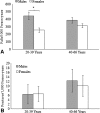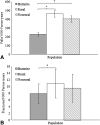Do Sex Differences Exist in Rates of Falls and Fractures in Hutterite, Rural, and Nonrural Populations, Aged 20 to 66 Years?
- PMID: 25762018
- PMCID: PMC4488222
- DOI: 10.1007/s11999-015-4248-3
Do Sex Differences Exist in Rates of Falls and Fractures in Hutterite, Rural, and Nonrural Populations, Aged 20 to 66 Years?
Abstract
Background: Falls and fractures are a major public health concern with an economic impact of more than USD 19 billion per year. Extensive research into the risk of falls and fractures in elderly populations has been performed; however, little is known about fall or fracture risk in younger populations. Additionally, sex- and population-specific (rural versus nonrural) fall and fracture risk may be important in identifying groups most at risk in an effort to develop preventive measures.
Questions/purposes: The purpose of this study was to determine whether sex and population (rural versus nonrural) differences exist in fall and fracture rates.
Methods: Data from 1256 (538 men) participants of the South Dakota Rural Bone Health Study, a population-based cohort study, including those living a rural lifestyle (n=349 non-Hutterites and 572 Hutterites) and a nonrural lifestyle (n=335), were used to address our a priori hypotheses. Health histories, physical activity recall, anthropometric measurements, and dual-energy xray absorptiometry measurements of body composition were obtained longitudinally from participants every 18 months for 7.5 years. Falls and fractures were self-reported and fractures were confirmed through medical record review. Incidence rates were calculated as the number of falls or fractures per 1000 person-years and generalized estimating equations determined the association of sex and population group with fall and fractures rates while accounting for the repeated longitudinal measurements on the same person. All models adjusted for age group, percent time in moderate and vigorous physical activity, lean and fat mass, grip strength, and previous diagnosis of osteoarthritis.
Results: Males aged 39 years and younger had a 135% greater fall risk than females in the same age category (p=0.03), but there was no differences between males and females 40 years of age or older (p=0.26; age-by-sex interaction, p=0.05). No sex differences were observed for fracture risk. After controlling for covariates, rural and nonrural individuals fell at higher rates than Hutterites (84% and 50%, respectively, p<0.001). Additionally, rural individuals fractured at a 72% greater rate than Hutterites after controlling for covariates (p=0.03).
Conclusions: Sex differences in fall risk among younger individuals along with population differences in fall and fracture rates suggest that sex and lifestyle factors may have an impact on fall and fracture risk. Future studies focusing on sex- and population-specific risk factors are necessary to develop prevention strategies tailored to specific populations.
Level of evidence: Level III, prospective study.
Figures


Similar articles
-
Rural versus nonrural differences in BMC, volumetric BMD, and bone size: a population-based cross-sectional study.Bone. 2004 Dec;35(6):1389-98. doi: 10.1016/j.bone.2004.09.005. Bone. 2004. PMID: 15589221
-
Low BMD is less predictive than reported falls for future limb fractures in women across Europe: results from the European Prospective Osteoporosis Study.Bone. 2005 Mar;36(3):387-98. doi: 10.1016/j.bone.2004.11.012. Bone. 2005. PMID: 15777673
-
Rural vs. non-rural differences and longitudinal bone changes by DXA and pQCT in men aged 20-66 years: A population-based study.Bone. 2015 Oct;79:79-87. doi: 10.1016/j.bone.2015.04.045. Epub 2015 May 6. Bone. 2015. PMID: 25957824 Free PMC article.
-
[Muscle and bone health as a risk factor of fall among the elderly. Epidemiology of falls and fractures].Clin Calcium. 2008 Jun;18(6):747-53. Clin Calcium. 2008. PMID: 18515942 Review. Japanese.
-
The changing epidemiology of fall-related fractures in adults.Injury. 2017 Apr;48(4):819-824. doi: 10.1016/j.injury.2017.02.021. Epub 2017 Mar 2. Injury. 2017. PMID: 28283181 Review.
Cited by
-
Helicobacter pylori Related Diseases and Osteoporotic Fractures (Narrative Review).J Clin Med. 2020 Oct 12;9(10):3253. doi: 10.3390/jcm9103253. J Clin Med. 2020. PMID: 33053671 Free PMC article. Review.
-
The epidemiology of adult fractures according to the AO/OTA fracture classification.Ulus Travma Acil Cerrahi Derg. 2022 Jan;28(2):209-216. doi: 10.14744/tjtes.2020.26374. Ulus Travma Acil Cerrahi Derg. 2022. PMID: 35099031 Free PMC article.
References
Publication types
MeSH terms
Grants and funding
LinkOut - more resources
Full Text Sources
Other Literature Sources
Medical
Research Materials

